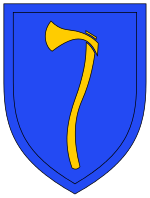Northern Army Group
| Northern Army Group | |
|---|---|
|
NORTHAG insignia | |
| Active | 1 November 1952 - 24 June 1993 |
| Allegiance |
|
| Part of | Allied Forces Central Europe |
| Headquarters | Rheindahlen |
The Northern Army Group (NORTHAG) was a NATO military formation comprising four Western European Army Corps, during the Cold War as part of NATO's forward defence in the Federal Republic of Germany.
The Army Group headquarters was established on 1 November 1952 in Bad Oeynhausen, but was relocated in 1954 to Rheindahlen. The HQ complex near Mönchengladbach contained NORTHAG HQ and three other command posts; the headquarters of the Second Allied Tactical Air Force (2 ATAF), British Army of the Rhine (BAOR) and Royal Air Force Germany (RAFG).
Previously, 21st Army Group had been on the left flank of the Allied advance into Germany, and had advanced into the North German Plain. This may have been the reason that a four-corps sized formation was given the title of 'Army group'.
Badge
During the construction of the main building of the joint HQ, the JHQ (Joint Headquarters), a Frankish battle ax (Francisca) was found. It was the badge NORTHAG chose because the Franks were a West-European tribe fighting against attackers from the East. The Franks defeated in the year 451 AD, an army under the leadership of Attila in Châlons-sur-Marne and ended thus a conquest of Western Europe by the Huns.
Structure
In the NATO command structure NORTHAG belonged to Allied Forces Central Europe (AFCENT), which in turn reported to Supreme Headquarters Allied Powers Europe (SHAPE). NORTHAGs responsibility was the defense of the North German plains from south of the river Elbe to the city of Kassel. The defense north of the Elbe was the task of Allied Land Forces Command Schleswig-Holstein and Jutland (COMLANDJUT), while south of Kassel it was the task of CENTAG.
Commander in Chief of NORTHAG was the commanding General of the British Army of the Rhine (BAOR). Chief of Staff was a German Major General, with a Belgian or Dutch Major General as alternates.
Northern Army Group was assigned the following formations:
- I Dutch Corps (Dutch 1st, 4th and 5th Divisions.[1] From July 1985 the German 3rd Panzer Division was added.[2]
- I German Corps (1st Panzer Division, 7th Panzer Division, 11th Panzergrenadier Division, and 27th Airborne Brigade.)
- I British Corps (1st Armoured Division, 3rd and 4th Armored, and 2nd Infantry Division)
- I Belgian Corps (1st Infantry and 16 Armored Division)
- III French Corps as reserve corps (2nd Armoured Division, and 10th Armored, and 8th Infantry Division (France))
III (US) Corps was assigned as reserve corps. 3rd Brigade, 2nd Armored Division was forward deployed at Garlstedt. The rest of 2nd Armored Division, along with 1st Cavalry Division, 5th Infantry Division (Mech), 212th Field Artillery Brigade and 3rd Armored Cavalry Regiment would join NORTHAG through OPERATION REFORGER within days after an outbreak of hostilities. They would draw their equipment from POMCUS depots in the Netherlands, Belgium and North Rhine-Westphalia.
These organizations fell in peacetime under their respective national command authorities. Only in the case of attack did operational control over the Corps automatically transfer to NORTHAG. Air support was provided by 2 ATAF.
During peacetime NORTHAG multi-national staff commanded the following units:
- 13th Belgian Telecommunications Company (13 Cie T Tr)
- 28th Signal Regiment, Royal Signals (NORTHAG)
- German Telecommunications Battalion 840 (NORTHAG)
- Dutch telecommunications company
- NORTHAG telecommunications company (radio NORTHAG Air Support Squadron), which consisted of soldiers from all four nations.
In the case of war the headquarters of the 2nd ATAF and NORTHAG would be relocated to the JOC (Joint Operations Center), a bunker complex in the St. Pietersberg in Maastricht area.
Field Operations
In the NATO defense plan, NORTHAG was assigned the area between Hamburg and Kassel (North-South) and the German-Dutch, Belgian to the (then) inner-German border to defend against a potential threat from the Warsaw Pact. The locations of NORTHAG forces were accordingly, mostly in this area. In the north the command bordered Allied Forces Northern Europe (AFNORTH) and in the south the Central Army Group (CENTAG).
Under General Sir Nigel Bagnall, NORTHAG tried to reorientate its defensive plans from a static defence to a more mobile approach.[3]
Ground operations relating to the crisis in former Yugoslavia began in late 1992. In November 1992, the United Nations Protection Force in Bosnia-Herzegovina was provided with an operational headquarters drawn from HQ NORTHAG, including a staff of some 100 personnel, equipment, supplies and initial financial support.
Disbandment
On 24 June 1993, the headquarters of NORTHAG and 2 ATAF officially disbanded during a military ceremony. The last commander of NORTHAG was General Sir Charles Guthrie, KCB LVO OBE.[4] The last Chief of Staff was Major General Helmut Willmann, later commander of the Eurocorps.
References
- ↑ David Isby and Charles Kamps, Armies of NATO's Central Front, Jane's Publishing Company, 1985, p.331-3
- ↑ O.W. Dragoner, Die Bundeswehr 1989 part 2.1, page 59
- ↑ See Mackenzie, J. J. G., and Brian Holden Reid, eds. The British Army and the operational level of war. Tri-Service, 1989.
- ↑ NATO profile: Sir Charles Guthrie
- "Army Group North brochure Editor: HQ NORTHAG 1987
- "The five headquarters in Mönchengladbach", brochure monk Koblenz-Verlag, 1987
- "The History of the Northern Army Group", Editor: HQ NORTHAG, 1993
Further reading
- David G. Haglund and Olaf Mager (eds), Homeward bound? : allied forces in the new Germany, Westview Press, 1992. xi, 299 p. : ill. ; 22 cm. ISBN 0-8133-8410-9.
